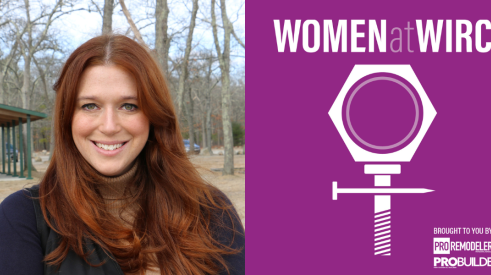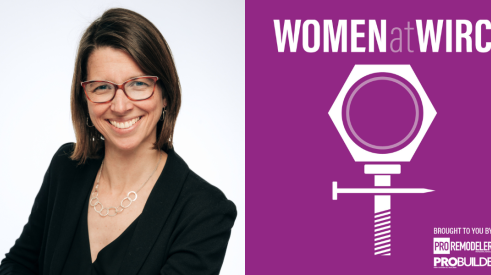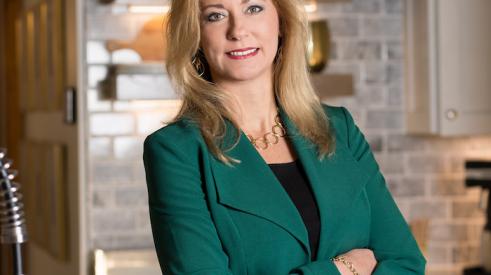 |
|
Jud Motsenbocker |
Referrals are the bread and butter of the remodeling business, but not all referral leads are created equal. Whether a prospective client finds a contractor via a friend or a phone book, the remodeler has the responsibility of choosing projects that will fit the company's schedule and resources and be most profitable. Jud Motsenbocker asks Tom Lykos and Chuck Russell how they choose their clients.
Jud: How do you qualify leads?
Tom: We have what we call a lead sheet. When somebody calls our office, typically our office manager answers the phone. That happens to be my mother. She will go through a quick list of questions that we ask all our sales leads — name, address, phone number, if they're in a single-family home or a condominium. We get a quick definition of the scope of work.
And — something that's very important to us — we ask them where they got our name. If it's from advertising, we know what advertising is working. If it's from a past client or vendor, then we make sure we express our appreciation to that referral source.
We pass that lead on to one of our two salespeople and they get into more detail on the scope of work. They ask about the client's desired schedule and budget. Then we make an appointment. We let the client know on the first phone call what the remodeling process is.
Chuck: We have a lead qualification form, but where we differ is I want that initial call to be the initial qualifying call. We have spent a lot of time training our office manager, and she's the only one who takes those calls. She does a pretty extensive question and answer with the client. Some of the things she talks about are the job, financing, budget, time frame. A lot of our qualifying is more on personal and cultural fit than on any other criteria. She does a fantastic job at that. Our form has several red flags that can be checked.
 |
|
Chuck Russell, Owner |
At that point, she passes it on to our sales manager, unless it's something she knows just flat won't work, like if it's on the other side of the state, a do-it-yourselfer or a shopper.
The sales manager fills out the lower section of the form. He makes the final decision on whether we'll pursue that lead or not. If there are too many red flags when he gets through, then he'll politely refuse to do the job. Otherwise, he passes it off to sales and we continue to qualify throughout the sales process.
During the first meeting, we have a client survey that the salespeople are required to go through to get to know the people better and find out where they're coming from. It's one of the first things he does after the warm-up, get-to-know-you introduction. He tells them in order to service them better, we need to ask them a few questions. By the time he gets there, we've decided geographically it works, and it fits into our schedule. Now we're qualifying fit, personality, culture and budget. By the time you've asked all 11 questions, you have an idea if it's a good fit. We continue qualifying past the first two phone calls right into the actual sales process.
Jud: Do you set priorities on leads? In other words, is it a one, two, three, four system?
Chuck: Yes. When the office manager's finished with it, she gives a 1 to 5 rating on several topics that can be red-flagged — enthusiasm, price-shopping, opinion, detail-oriented, agreeable, realistic. Also geographic location and lead source. So, we do a 1 through 5 grade and that number is the priority she comes up with. The sales manager does the same thing when he reviews it, and the final number is our priority number.
 |
|
Tom Lykos, CGR, CAPS, President |
Tom: We have a more informal process for that, and we usually do it after the first sales call. The salespeople will come back with their notes on the jobs, we'll look at our current backlog of work and at the location of the project. Then, we make a decision as to whether or not we have an interest in the job.
Jud: What is the salesman's closing word after this first meeting? At that point you may not do this job.
Tom: Typically, at the end of our first meeting, we are asking the client to commit to a design agreement. That is an analysis of the project in terms of the scope of work, the schedule, the budget. Our goal at the end of the first sales call is to get the design agreement, which for all intents and purposes takes them off the market. Now we start our working relationship. I try to get that commitment from the client as quickly as I can.
We sell 50 to 75 percent of our business during a three- to four-month period every year, so we have to figure out very quickly what jobs we will or won't do. We try to get as many clients to commit to a design contract as quickly as possible. That allows us to build up our backlog for the whole year and still work through the qualifying as well.
Chuck: We do it a little differently. We're set up for a two-call close. The first call is a little more qualifying. The sales people have the design budget development contract with them, and it's already got the people's name on it. Probably 20, 30, 40 percent of the time they get their signature. But we focus on a second-call close. I don't want to commit to any kind of contract until that salesman comes back with the survey and he and the sales manager agree that we're going to proceed with this.
Jud: Chuck, how do you set the priorities for that lead?
Chuck: Probably our highest priority is the lead source. Most of our marketing effort is relationship marketing with our past customers, so if the lead source is coming from them, we're going to service that source. We have to keep that momentum going. We have a referral program with our past customers that's mentioned in our newsletter. We don't want to let anybody down.
Our number two priority would be geographic location. If it's too far out of our area, then we obviously can't do it. We have a network of other contractors that we pass it off to.
Sometimes it's just a feeling. We have red flags about Boeing engineers. They have a terrible reputation to work for. I've always believed that there are diamonds in the rough. We give everybody the benefit of the doubt, and we will really try to service a call, even if it's to make a second call and hand them off to someone else. We don't say just because they don't fit a certain set of numbers that we're done. We spend a little time with everybody who calls.
Jud: Tom, how do you prioritize calls?
Tom: We take the referral source as our primary deciding factor. Past clients are automatic. Most of our work is by referral, and they're a big referral source for us, so anything they want us to do, we find a way to get it done. When we get a lead from a past client, we consider that a pretty solid lead. It's almost like the client has to do something to make me not want to work for them.
The second thing is the job type. Unfortunately, because most of our clients are part-time residents, they typically don't know who else to call. They might call us for handyman work or a single-trade project. If a past client has referred us to somebody who needs to have a room painted, we're not going to take that job and manage it — we'll refer them to someone who does painting.
We work in a pretty small geographical area, so location isn't a factor.
Jud: Do you accept any job when the client specifically wants you?
Tom: Yes, if it's a referral from a past client. If it's a condominium building we do a lot of work in, we won't necessarily take that job hands down, but we'll certainly consider it a qualified lead and give it a high priority. If the lead was out of a magazine, we probably wouldn't take that job.
Chuck: Generally, we would consider it a very high priority job if someone says, "We want you to do our kitchen, and we're not talking to anyone else."
Past clients have our trust and confidence, so they deserve our best effort. We're ready to help them even if we have to disqualify someone new who might be a pretty good candidate in order to fit them in. Probably 20 to 25 percent of the jobs we have going at any one time are for past customers. That takes some of the peaks and valleys out of the equation.
For past customers, we do everything. We have a small jobs division, and an in-house architect and design division. We also have painting crews. If it's a past client, I don't care if it's adjusting a doorknob, we'll be out there because I don't want anyone else in my client's houses.
Jud: What other specific questions would you ask?
Chuck: We start out asking about plans and drawings and if they're working with an architect. If they have an architect on board, that's a red flag. We don't often work with other architects, and normally they don't work out that well for us.
We ask if any other companies will be looking at the project. If they say yes, we'll ask who's on their bid list. They need to answer those honestly. They could get half a red flag if there's hedging in the answer. Some of these questions are just to see how open people are. We're a very open company and we want our clients to be the same.
Tom: We have three big issues at the beginning of the relationship. One, we ask about schedule. With our part-time residents, everybody wants the work to start when they leave to go back home and want it done by the time they return. It's important that we find out from the client what their expectations are. If somebody calls us in January and wants us to start in February, that's not realistic. If they haven't set their expectations, then we have the opportunity to set them.
Budget's also very important. A lot of people here have a home up north that they've lived in for decades, and they may or may not have had work done on it. They get a little bit of sticker shock when they find out how much it's going to cost. It's important for us to find out as quick as we can what their expectations are for budget. If they've bought property down here recently, they understand that things are pretty expensive down here compared to up north. That's a good sign.
One thing I hate to hear is when people say, "I remodeled my kitchen 15 years ago for $17,000." Those clients we know we're not going to be able to work with. If they have a realistic schedule or are open to talk about schedule, or if they're open to a reasonable budget, those are good signs.
We also want to find out if they're familiar with our work. We do work in condominium buildings and typically we find that other residents in the building look in on our project. By the time they call us, they've met our employees, they know the caliber of our work and we're already established with them. Those are really our ideal clients.
Jud: What information do you absolutely have to have, and what would indicate to you what the red flags are?
Tom: Expectations for schedule and budget. If I can't get that information up front, then I know I'm going to have trouble with them later. Those are the two key things before I even go out on the first sales call.
Chuck: Time frame or schedule for the project is required. If they don't want to answer or if it seems like it's going to be a problem, then the grade will be lower. Budget information is required. If they don't feel comfortable giving it, it's not something we'd totally throw the lead away over, they would just get a little lower score.
We require at least three phone numbers and an e-mail address. The cell number is a more personal way to get a hold of them. That's a sign that they're serious and ready to talk.
Jud: Give me three or four of your red flags.
Tom: Number one would be an unreasonable expectation of schedule. If they're waiting until the last minute to call us — that means they've already called someone else and for some reason they weren't happy. Now they're reaching for straws to get something done before they leave.
When it comes to budget, if clients are unsure, it doesn't necessarily mean they can't afford it. They might not know how much it will cost. Our salespeople are trained to discuss numbers with people on the first sales phone call. If a client doesn't have a budget in mind, we'll discuss that with them prior to the first on-site visit.
We tell them, "If you can't tell me how much you want to spend, then we can't design a project for you that meets all of your needs at your budget." We tell them, "In a design/build relationship, our job is to get you the most for your money." That's where value engineering comes into play.
Chuck: I think the first red flag is the openness of the people that call. It could be about budget, schedule, anything. If they have an architect already on board, that's a flag. If they're having more than two companies review the project, that's a flag. If it goes to three, four or five, that's several flags. Time frame, schedule would be a flag. Budget issues. There are some jobs we don't feel we can do efficiently to make the people happy. You know, do a little over here, a little over there. Those are red flags for us. We call those the scrambled eggs jobs.
Some of the questions we ask refer to when you purchase projects, what do you look for for, quality or price? Flags can come out of those questions.
Continuation of the discussion from the magazine article:
Jud: If a caller says "free estimate," we shut the call off right there and give it to a salesman. We let the salesman pursue it further and let him find out why and what they're after. Does a red flag come up when somebody asks if you give free estimates?
Tom: Absolutely! Our salespeople tell them up front the design fee and that typically, we'll sign that contract during the first visit. When a client calls and their first question is "Do you guys do free estimates?" that's a red flag.
Chuck: I don't know if it's a red flag, because a lot of people are told at the home shows to ask for free estimates. We don't give free estimates, but we do give free ballpark prices.
Jud: Do you qualify the lead differently depending on what size the job is?
Chuck: If it's a large keystone job, if it could turn into our anchor job for the year, we would look at that very seriously. We would probably spend more time on it if it fit geographically and with our schedule. We look at small jobs just as seriously because we have to keep the small-jobs division busy.
Tom: We'll do small projects for past clients automatically, without question. My father has a small handyman company, so any lead we consider a handyman project we forward to my father.
Jud: Take a very difficult project that's going to take an enormous amount of coordination. Do we pass on that when qualifying or do we jump on that and say, "Let me show 'em what a good job I can do."
Tom: If the referral is from a very good client, that certainly would play a part in the decision-making. We have a job right now where the children's part of the house has mold. I may regret it, but I feel that I owe those children to get that house remediated and put back together.
Part of it's ego, and I want to prove what I can do. But in the end, we're in a service industry and we have to serve people. So we try to estimate the job properly, build in the appropriate amount of profitability and serve the client the best that we can.
Chuck: It would be the kind of job I'd jump in and do because we do tough jobs. We've got a reputation for that. Generally, those jobs carry a higher price tag so it would be more profitable if we could pull it off.
Part of my criteria is based on company capacity, both in manpower and equipment. If a complicated job takes a large percentage of my mental, emotional, financial or equipment capacity for the year, then we're going to have to charge more for it. If this job would take more than I felt we could spare, then I would probably look at refusing it.
When an opportunity comes up, we look at which of our job foremen are available. It might be a really great job but if we can't allocate our resources to it, then we can't take it. At the same time, we might take a job that isn't as attractive if it fits in with our current workload.
Jud: Have you ever ignored the warning signs of a potentially bad client?
Chuck: I can think of more than one, especially in my past. I tended to want to do every job in town, saying, "I can make it work, I can work with anybody." We had a customer in a very up-scale neighborhood that we liked. The first red flag was the house. It was totally deteriorated. They had it custom-built for them around 1953, and they never touched it after that. The owner was a retired engineer. There's another red flag. He was going to be there every day. The wife was also retired, and she was so tight she squeaked.
I ignored all of these flags: It was a neighborhood where we worked a lot, and I don't like to see other guys truckin' in. I figured I'd put my best lead carpenter on it, and he could make them happy, even though I knew deep down that it would be a struggle. This is a job that I sold, so I'm to blame. If my salesman sold this job he would've been drug up on the carpet.
The job was scheduled for six weeks, and it took six months. They kept changing their minds. The wife didn't want to pay the bill. Even half of the signs should've disqualified the job. I ignored them thinking we could use the work and the revenue. I went against my gut feeling. Whenever I do that, I get burned.
Tom: I've got more than one example. The one I'll describe briefly is the man who runs a cabinet manufacturing company and who's an accountant. In the very beginning when we were building his budget, he started questioning every single line item, asking for breakdowns of every dollar that was going into his job. We should've run from that project. Of course, I'm the owner of the company and I can do whatever I want, so we moved ahead.
It was in a condominium building that we do a lot of work in, and I had to protect my reputation. I probably did the job for all the wrong reasons. It ended up demoralizing a lot of people in the company. They even questioned our supervision skills. The job turned out very nice from a quality and profitablilty standpoint, but emotionally, it wasn't worth doing.
Jud: How do you assure yourself that a client has realistic expectations to avoid any costly legal problems, delays or change orders in the job? Do you have a process?
Tom: Our contract has clauses regarding dispute resolution, invoicing and those kind of things. We have a page and a half on how change orders are handled. In the course of our relationship with our client, we discuss how we handle change orders. We try to discuss all the things we anticipate coming up. If we end up with a dispute over money, we go to mediation first.
Chuck: We continue to qualify all the way through the sales process. Even though we have a design development contract, we're still qualifying right up to the construction contract. If it looks like it isn't going to work for either party, we work on a way to separate during the budget development, even if we have to give them money back.
Tom: In the last two years, we've returned full or partial design fees to, I think, two clients. As you build the relationship you may find for whatever reason you're not able to get it together. You just part ways the best that you can.
Jud: Even though you both have good qualifying systems in place, you still have that happen once in a while.
|
Qualifying a lead is crucial to a successful project
Add new comment
Related Stories
How to Create a World-Class Remodeling Team
Great remodeling companies position themselves for the future with the right players
Everyone Should Have a Number: KPIs for Your Design Build Team
Measuring key performance indicators guides your team to success while creating accountability and ownership
How to Revamp Your Pre-Construction Process
Experiencing too much slippage and delays? See how Bridget Bacon of Red House Design Build solved these issues by improving the remodeler's pre-construction process
How This Remodeler Revamped Their Pre-Construction Process
Bridget Bacon of Red House Design Build outlines how she helped transform the pre-construction process for improved finances and morale
Building A Small Projects Division from the Ground Up
Through hard work and careful strategy, Harth Home Services has seen big growth
A Mindset of Serving Others
A research study shows surprising results about what makes us take ownership of our work.
3 Keys to Successful Team Management
On this episode of Women at WIRC, hear Laura Burnes delve into her approach to leadership and project management, in addition to sharing insights into Adams + Beasley Associates' winning culture.
4 Steps to Prep Your Business for Contraction
How a remodeling company plans ahead for the worst of times (and the best of times)
Helping Remodelers 'Get Their House In Order'
From remodeler to NARI executive to industry consultant, Diane Welhouse uses her expertise to help business owners












